Colorectal cancer (CRC) is the most common cancer in the Netherlands. Each year, around 2.5 million people are invited to participate in the national CRC screening program. However, in 2022, over 650,000 people either did not participate or failed to follow up after a positive test result.Many of these dropouts occur due to stress, fear, lack of information, or digital barriers. Harmony – Inform and Support addresses this challenge by introducing a Digital Intake Tool (DIT) that provides individuals (aged 55–75) with accessible information, emotional support, and user-centred digital guidance. Our goal was to apply health psychology and behavioral science to redesign the intake experience and reduce emotional and practical barriers throughout the screening journey.
Harmony: Inform and Support
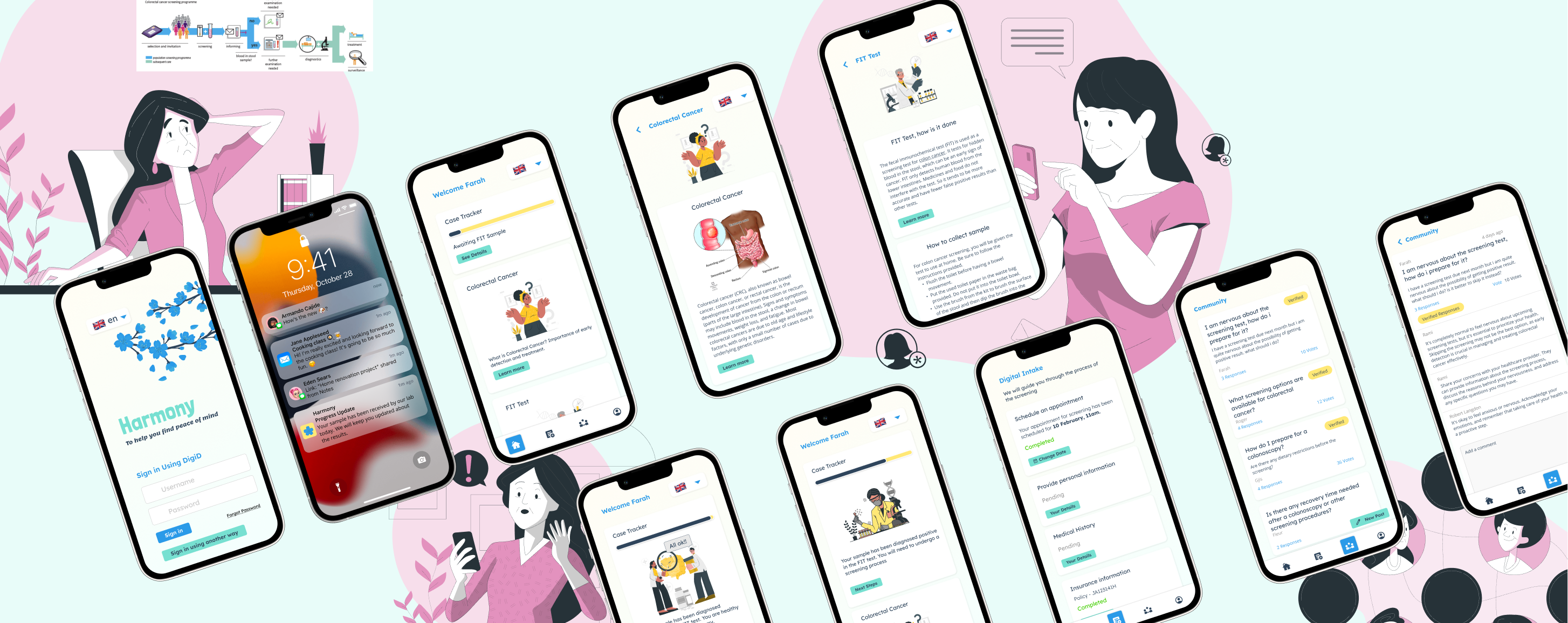
Issuer
TU Delft
Team
Britt Van der Rijt, Jingyi Zhao, Lori Lo, Yallaling Naik
Deliverables
Contextual Research, User Journey, Prototype of a new Digital Intake Tool (DIT)
Roles
UX Designer, Service Designer
Brief
How might we design a digital intake tool that helps users cope with stress, feel supported, and stay engaged throughout the CRC screening process?
Process
The design process followed four key phases, each aligned with behavioral design principles and user insights:
1
Literature and Context Review:
Analysed CRC screening data, policy documents, and psychological research. Identified structural and emotional barriers to participation. Mapped existing screening journey and stress points.
Analysed CRC screening data, policy documents, and psychological research. Identified structural and emotional barriers to participation. Mapped existing screening journey and stress points.
2
Behavioral Diagnosis:
Applied the Transactional Model of Stress and Coping to user experience. Identified stress appraisal moments and common coping failures. Defined behavioral objectives for each stage of the journey.
Applied the Transactional Model of Stress and Coping to user experience. Identified stress appraisal moments and common coping failures. Defined behavioral objectives for each stage of the journey.
3
Ideation & Concept Development:
Co-created initial ideas in team workshops. Sketched prototypes for emotional and informational interventions. Iterated based on design critiques and emotional mapping.
Co-created initial ideas in team workshops. Sketched prototypes for emotional and informational interventions. Iterated based on design critiques and emotional mapping.
4
Prototype Design & Evaluation Plan:
Created a low-fidelity flow of the Harmony tool. Designed screen content and interaction principles. Planned user testing through emotional scenario walkthroughs and adapted PSSUQ surveys
Created a low-fidelity flow of the Harmony tool. Designed screen content and interaction principles. Planned user testing through emotional scenario walkthroughs and adapted PSSUQ surveys
How Psychological Models Shape the User Experience
The design of Harmony is rooted in two key psychological models: the Transactional Model of Stress and Coping and the Theory of Planned Behaviour. When users receive a colorectal cancer screening invitation, stress arises as they assess if it’s a serious threat (primary appraisal) and whether they have the resources to cope (secondary appraisal). To address this, we created clear, step-by-step guidance combined with visual, textual, and video support, ensuring all users feel capable. Emotional support is provided through a moderated community where users share stories and get expert advice, reducing anxiety. The Theory of Planned Behaviour shaped how I fostered positive attitudes with jargon-free content, encouraged social norms via community engagement, and increased perceived control with progress tracking and timely feedback. Together, these models helped users feel informed, supported, and confident, boosting their intention to participate and complete the screening process successfully.
What makes this approach different?
Instead of flooding users with medical facts only after a positive test, Harmony intervenes early and empathetically, smoothing both emotional and practical obstacles. By building on established psychological theories, every app decision aims to lower barriers and empower people, especially those who otherwise might avoid screening out of fear or confusion.
What makes this approach different?
Instead of flooding users with medical facts only after a positive test, Harmony intervenes early and empathetically, smoothing both emotional and practical obstacles. By building on established psychological theories, every app decision aims to lower barriers and empower people, especially those who otherwise might avoid screening out of fear or confusion.

Target Persona
Farah is a 65-year-old woman living in the Netherlands. She is moderately comfortable with digital tools, but she doesn’t consider herself tech-savvy. She speaks Dutch and prefers content written in simple, reassuring language. Emotionally, Farah tends to feel nervous when she receives medical letters, especially ones that suggest serious follow-up. What she needs most is clear, step-by-step guidance, emotional reassurance that she’s not alone, and a feeling of human connection, even when interacting with a digital system. Farah shaped our decisions around language simplicity, emotional design, and interface layout. Her fears and needs directly informed our intervention strategy.
Current User Journey
Users received a formal government letter and a stool sample test kit by mail, often accompanied by medical jargon and unclear instructions. This led to confusion and anxiety, especially for those with limited digital or health literacy. Users had no immediate access to support or clear guidance on collecting samples and sending them back. They navigated the process—collection, mailing, and waiting for results—alone, with little reassurance or motivation. Results were sent by letter without timely updates, leaving many stressed and uncertain about next steps, especially if results were positive.
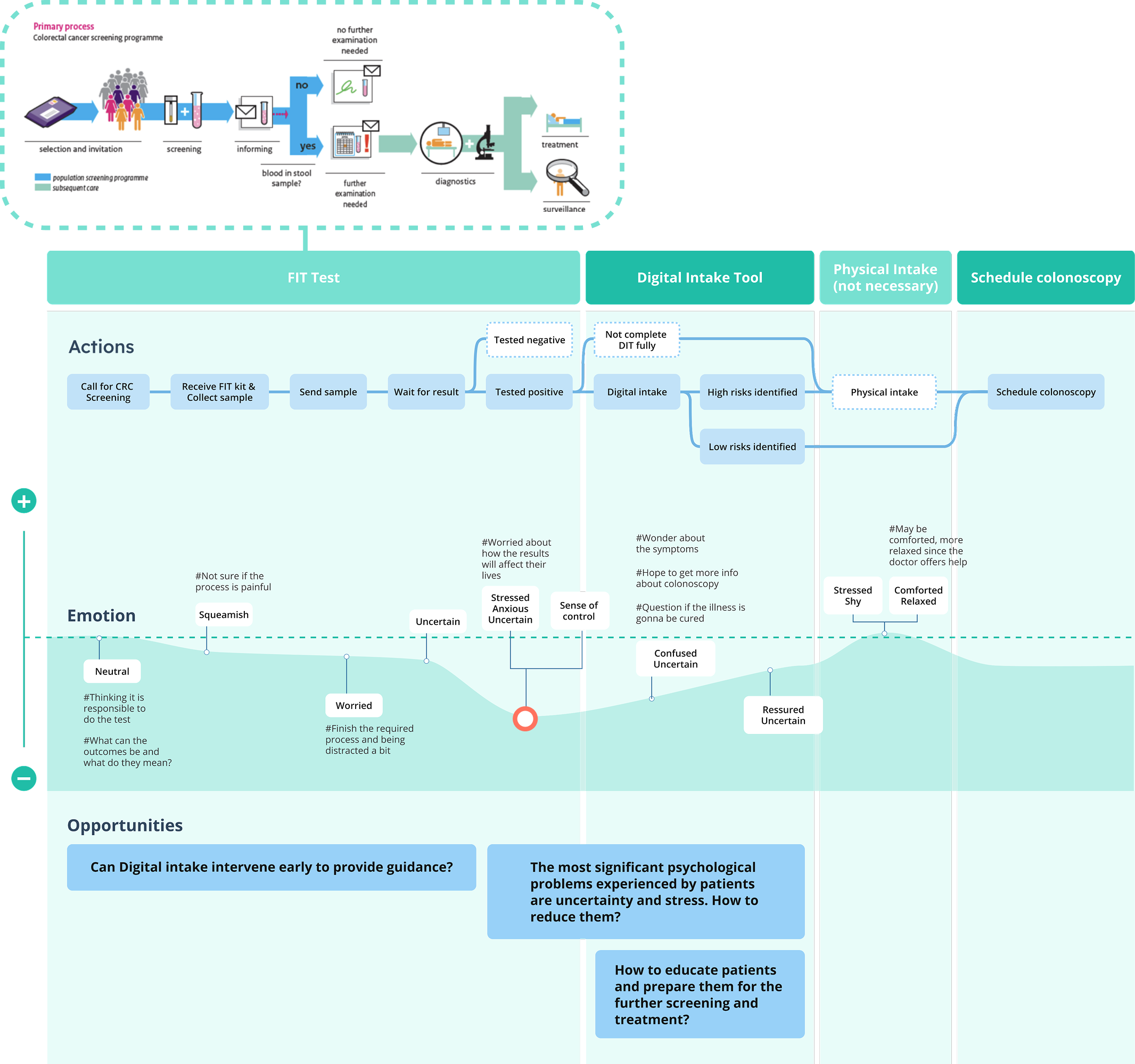
New User Journey
Part 1: Receiving the FIT Test Kit and Registering on the App
The journey begins when the user receives a letter along with the FIT test kit. For many, this can be an unfamiliar and even stressful moment. To reduce confusion, Harmony provides a QR code that guides users to register on the app. The onboarding experience is designed to be simple, visual, and available in multiple languages, helping users feel informed and supported right from the start.
Part 2: Learning About CRC and Reducing Uncertainty
Once registered, users can access bite-sized educational content that explains what CRC is, what the screening involves, and what the outcomes might mean. Harmony focuses on reducing fear and uncertainty at this stage, with gentle guidance, clear visuals, and calming tone. The app also offers early access to breathing techniques, journal prompts, and an explanation of common emotional responses—helping users manage stress before it builds up.
Part 3: Receiving Updates and Staying Informed
After users return the FIT sample, Harmony provides regular updates through a case tracker. This visual timeline shows whether the test has been received, processed, and when to expect results. This transparency replaces anxious waiting with calm anticipation, reducing the mental toll of not knowing what's happening behind the scenes.
The journey begins when the user receives a letter along with the FIT test kit. For many, this can be an unfamiliar and even stressful moment. To reduce confusion, Harmony provides a QR code that guides users to register on the app. The onboarding experience is designed to be simple, visual, and available in multiple languages, helping users feel informed and supported right from the start.
Part 2: Learning About CRC and Reducing Uncertainty
Once registered, users can access bite-sized educational content that explains what CRC is, what the screening involves, and what the outcomes might mean. Harmony focuses on reducing fear and uncertainty at this stage, with gentle guidance, clear visuals, and calming tone. The app also offers early access to breathing techniques, journal prompts, and an explanation of common emotional responses—helping users manage stress before it builds up.
Part 3: Receiving Updates and Staying Informed
After users return the FIT sample, Harmony provides regular updates through a case tracker. This visual timeline shows whether the test has been received, processed, and when to expect results. This transparency replaces anxious waiting with calm anticipation, reducing the mental toll of not knowing what's happening behind the scenes.
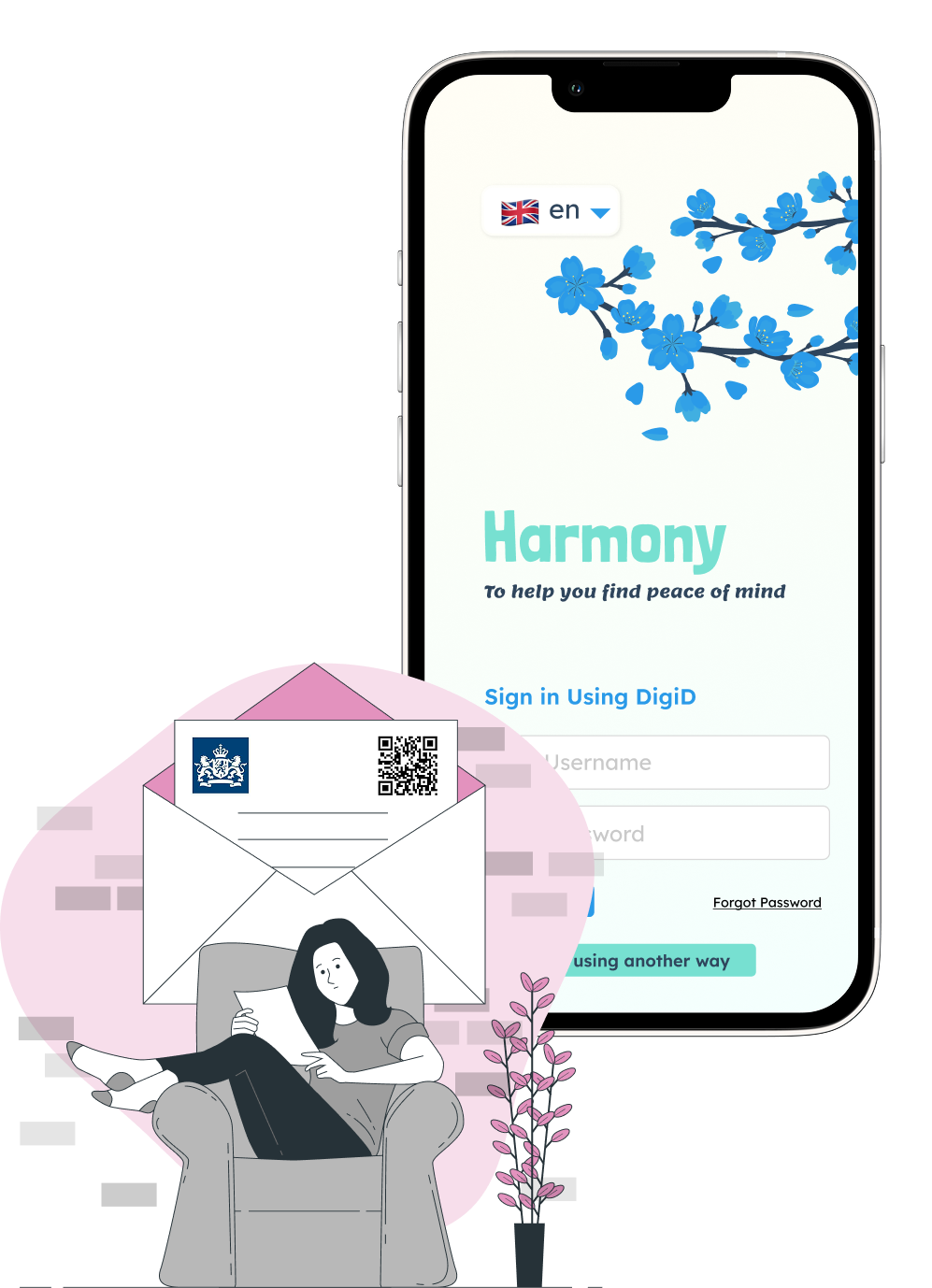
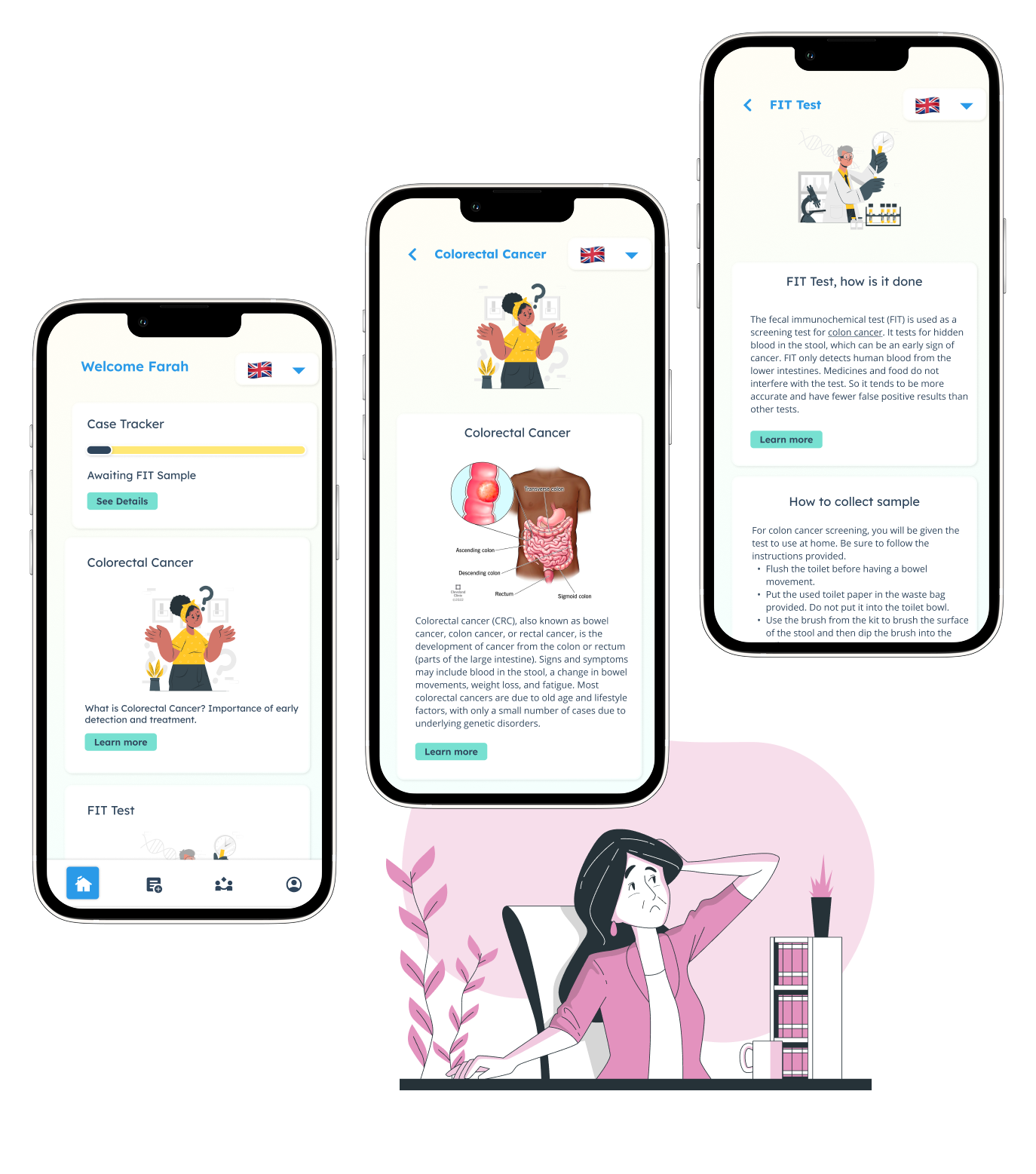
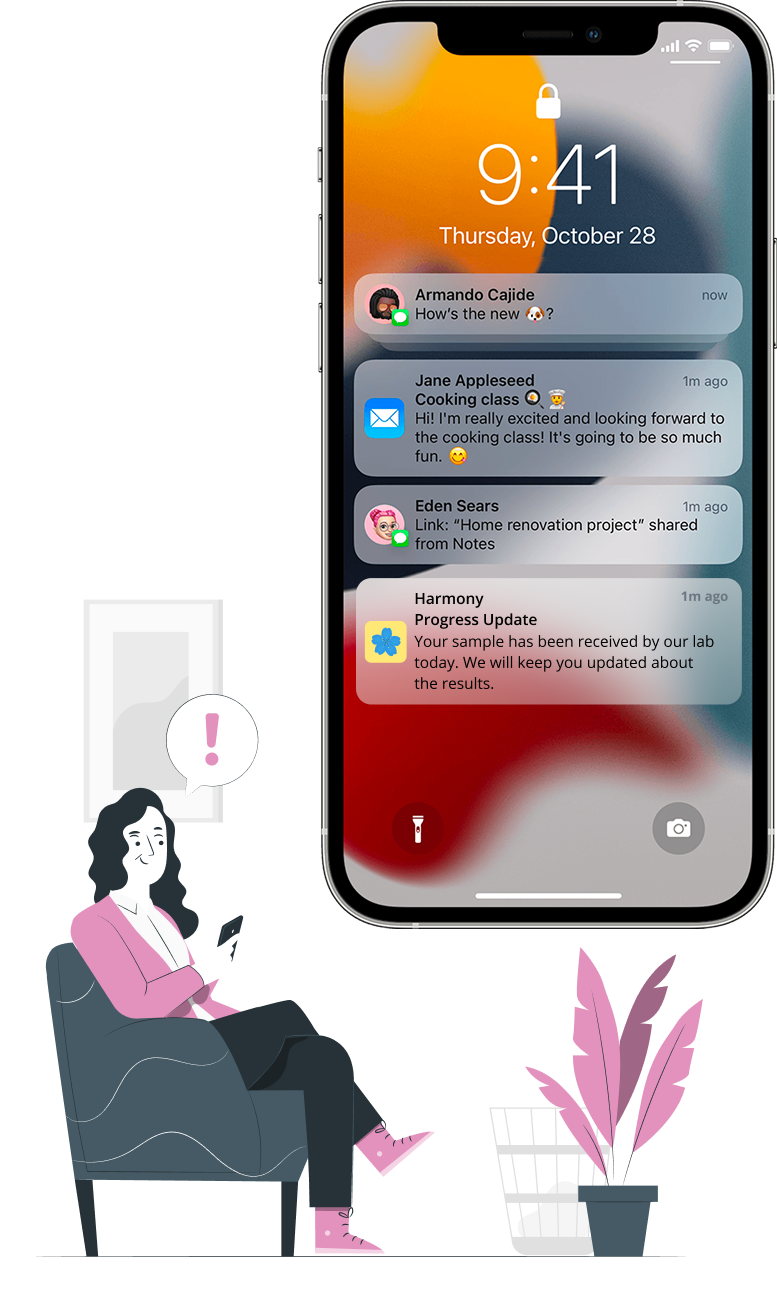
Part 4: Receiving Results and Preparing for Next Steps
Whether the result is negative or positive, Harmony offers a thoughtful, step-by-step explanation of what it means. If the result is positive, the app gently introduces next steps like scheduling a colonoscopy. It walks users through logistics, provides hospital contact info, and offers emotional support through tools like journaling and breathing exercises, helping users navigate one of the most emotionally intense moments with clarity and care.
Part 5: Connecting with the Community
Throughout the journey, users can choose to explore Harmony's community hub, a moderated, anonymous space where they can read others’ stories, ask questions, or just see how others are feeling. For users who feel isolated or unsure, this feature creates a safe space for connection, empathy, and reassurance.
Whether the result is negative or positive, Harmony offers a thoughtful, step-by-step explanation of what it means. If the result is positive, the app gently introduces next steps like scheduling a colonoscopy. It walks users through logistics, provides hospital contact info, and offers emotional support through tools like journaling and breathing exercises, helping users navigate one of the most emotionally intense moments with clarity and care.
Part 5: Connecting with the Community
Throughout the journey, users can choose to explore Harmony's community hub, a moderated, anonymous space where they can read others’ stories, ask questions, or just see how others are feeling. For users who feel isolated or unsure, this feature creates a safe space for connection, empathy, and reassurance.
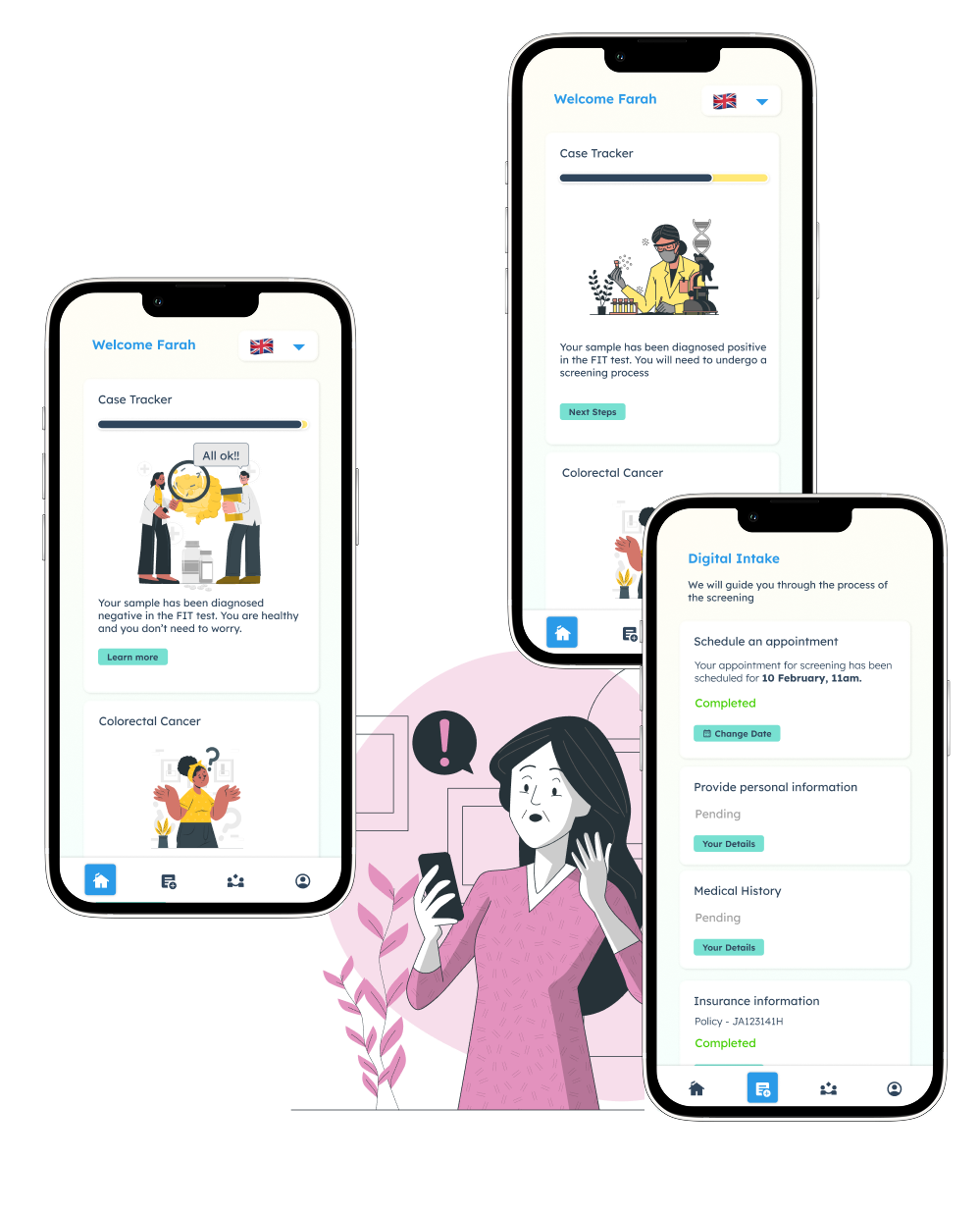
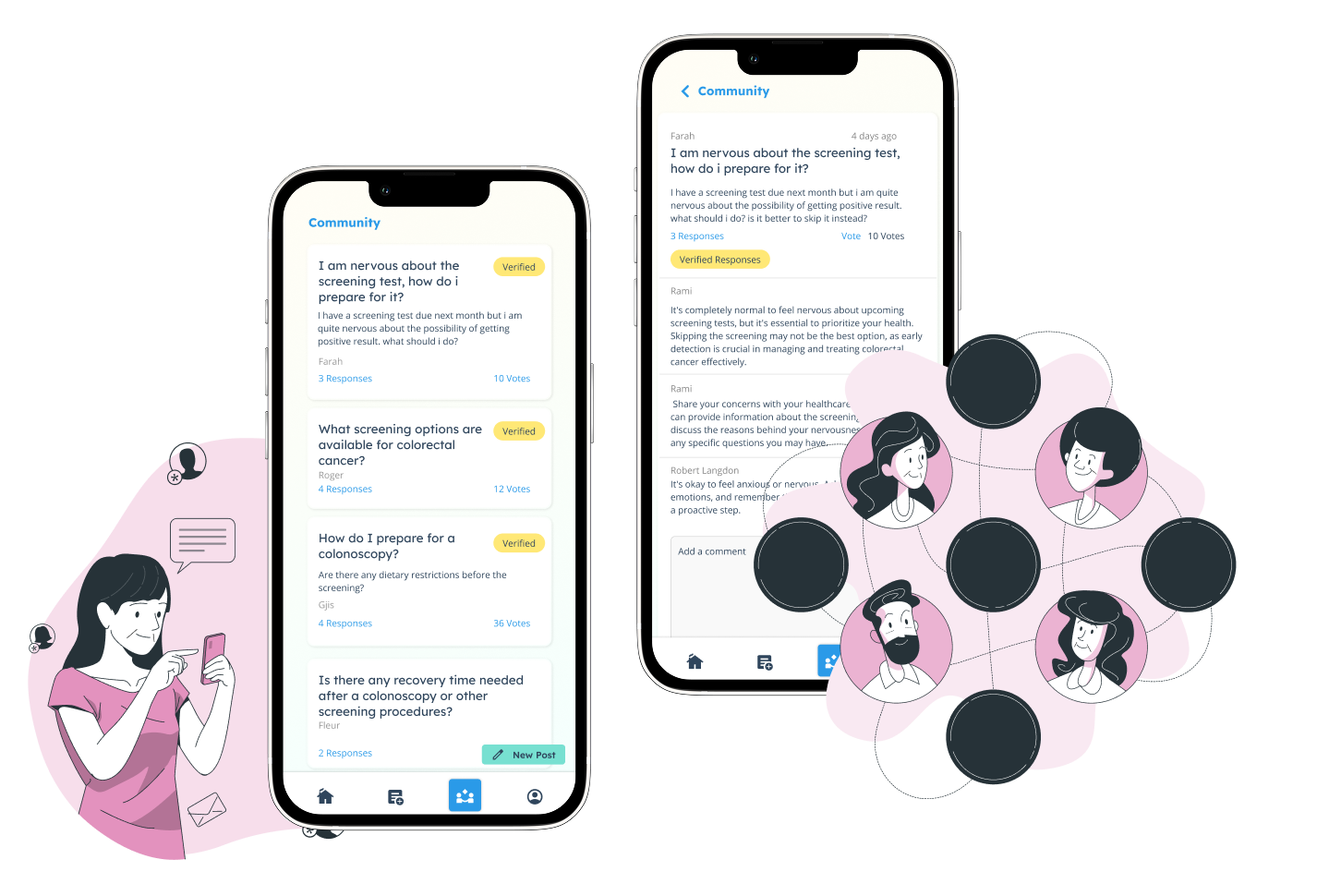
Bringing the Journey to Life
Visual-first Design: Simple navigation, calming blue and green palette reduce stress, accessible interface for all literacy levels.
Personalization: The first screen welcomes users by name and explains where they are in the screening journey.
Step-by-Step Guidance: Short modules use visuals, audio, and translations, no jargon, only essential information.Real-Time
Progress Tracking: Users see exactly where they are - “Sample Received,” “Result Pending,” “Next Steps”, which supports a sense of control.
Community Support: Anonymous discussion boards let users post worries or questions; verified medical experts and peers respond with empathy and facts.
Coping-Focused Features: Gentle notifications, tips for reducing anxiety, and links to additional help.
Personalization: The first screen welcomes users by name and explains where they are in the screening journey.
Step-by-Step Guidance: Short modules use visuals, audio, and translations, no jargon, only essential information.Real-Time
Progress Tracking: Users see exactly where they are - “Sample Received,” “Result Pending,” “Next Steps”, which supports a sense of control.
Community Support: Anonymous discussion boards let users post worries or questions; verified medical experts and peers respond with empathy and facts.
Coping-Focused Features: Gentle notifications, tips for reducing anxiety, and links to additional help.